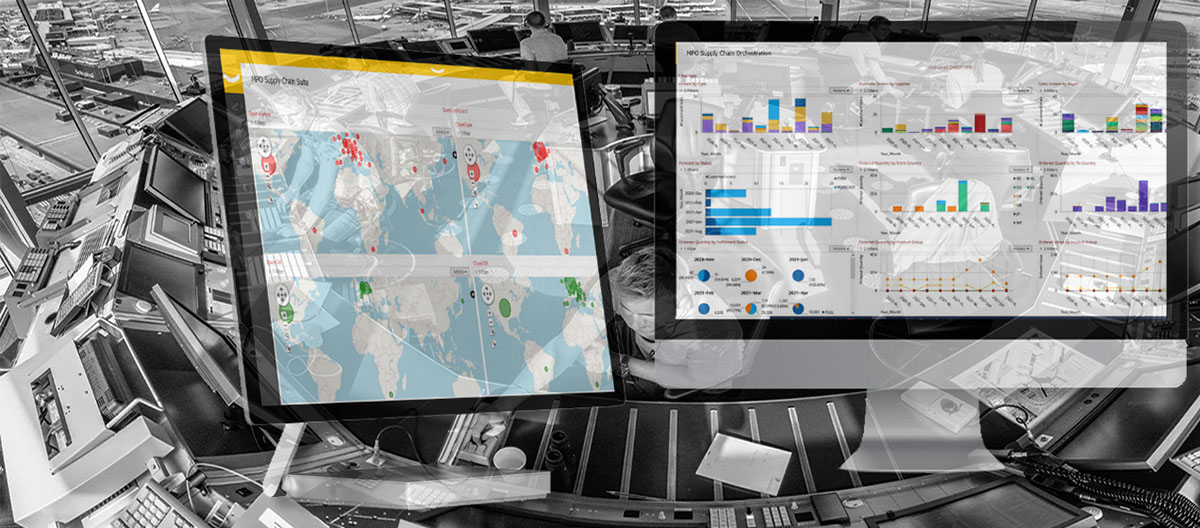

Finance
How To Mitigate Supply Chain Attacks
Published: October 19, 2023
Learn how to protect your finance against supply chain attacks with these effective mitigation strategies. Safeguard your business and financial data today!
(Many of the links in this article redirect to a specific reviewed product. Your purchase of these products through affiliate links helps to generate commission for LiveWell, at no extra cost. Learn more)
Table of Contents
- Introduction
- Understanding Supply Chain Attacks
- Common Techniques Used in Supply Chain Attacks
- Identifying Vulnerabilities in the Supply Chain
- Best Practices for Mitigating Supply Chain Attacks
- Effective Strategies to Protect Against Supply Chain Attacks
- Implementing Security Measures in the Supply Chain
- Building Resilience in the Supply Chain
- Incident Response and Recovery in Supply Chain Attacks
- Conclusion
Introduction
Supply chain attacks have become a significant concern for businesses and organizations in recent years. These attacks involve infiltrating the systems of trusted third-party vendors or suppliers, with the goal of compromising the target organization’s infrastructure and data. The consequences of a successful supply chain attack can be severe, including data breaches, financial losses, damage to reputation, and disruption of critical operations.
In a supply chain attack, cybercriminals exploit the trust and reliance that organizations place on their suppliers and vendors. By compromising a trusted entity within the supply chain, attackers can gain access to sensitive data, inject malicious code, or distribute malware to unsuspecting victims.
Understanding and mitigating supply chain attacks is crucial for organizations across industries. From financial institutions to e-commerce platforms, everyone is vulnerable to these attacks. It is essential to comprehend the common techniques used by attackers, identify vulnerabilities in the supply chain, and implement effective measures to protect against these threats.
This article aims to provide a comprehensive overview of supply chain attacks and offer practical guidance on mitigating the associated risks. By following best practices and implementing security measures, organizations can significantly reduce the likelihood of falling victim to these attacks and safeguard their operations and customers’ sensitive information.
Next, we will explore in detail the various techniques employed by attackers in supply chain attacks.
Understanding Supply Chain Attacks
Supply chain attacks are a type of cyber attack that focuses on infiltrating the systems and networks of trusted third-party vendors or suppliers. These attacks exploit the interconnectedness of modern supply chains, where organizations rely on external partners for various services and products.
The goal of a supply chain attack is to compromise the target organization’s infrastructure, gain unauthorized access to sensitive data, or distribute malware to unsuspecting victims. By targeting a trusted entity within the supply chain, attackers can bypass the traditional security measures implemented by the target organization.
One common type of supply chain attack is the software supply chain attack. In this scenario, attackers infiltrate the software development process and inject malicious code into legitimate software before its delivery to the end-users. Users unknowingly install the compromised software, allowing the attackers to gain access to their systems or steal sensitive information.
Another type of supply chain attack is the hardware supply chain attack. Here, attackers compromise the manufacturing or distribution process of hardware components, such as routers or servers. By tampering with the hardware, attackers can introduce vulnerabilities or backdoors, providing them with ongoing access to the targeted systems.
Supply chain attacks can have far-reaching consequences. For example, an attack on a cloud service provider could potentially compromise the data of numerous customers. Similarly, an attack on a payment processing company could expose the financial information of merchants and customers.
Supply chain attacks are particularly challenging to detect and mitigate as organizations often have limited visibility and control over their suppliers’ security practices. The interconnected nature of supply chains means that even a single compromised vendor can have a cascading effect on multiple organizations downstream.
In the next section, we will discuss the common techniques employed by attackers in supply chain attacks.
Common Techniques Used in Supply Chain Attacks
Supply chain attacks employ various techniques to infiltrate and compromise the systems of trusted vendors or suppliers. Understanding these techniques is crucial for organizations to identify potential vulnerabilities within their supply chain. Here are some common techniques used in supply chain attacks:
- Software or Firmware Tampering: Attackers may tamper with the software or firmware during the development process. They can inject malicious code or backdoors that remain undetected until the compromised software or hardware is in use by the target organization or its customers.
- Compromising Trusted Websites: Attackers can compromise the website of a trusted supplier or vendor and inject malicious code. When users visit the compromised website, the code may exploit vulnerabilities in their browsers or plugins, allowing the attackers to gain access to their systems.
- Malicious Updates: Attackers may compromise the update mechanism of a software application or operating system. By distributing a malicious update, the attackers can gain access to the target organization’s systems when the update is installed.
- Interception of Shipments: In hardware supply chain attacks, attackers may intercept shipments of devices or components and tamper with them. They can modify the hardware, install backdoors or keyloggers, or otherwise compromise the integrity of the devices.
- Counterfeit Products: Attackers can introduce counterfeit products into the supply chain. These products may appear identical to genuine ones but contain hidden vulnerabilities or backdoors that compromise the security of the target organization.
- Impersonation: Attackers may impersonate a trusted vendor or supplier to gain unauthorized access to the target organization’s network. By pretending to be a legitimate entity, they can exploit trust relationships and bypass security measures.
These techniques demonstrate the diverse range of methods that attackers employ in supply chain attacks. By staying informed about these techniques, organizations can better assess their risk exposure and take appropriate measures to mitigate potential threats.
In the next section, we will explore how organizations can identify vulnerabilities within their supply chain and proactively address them.
Identifying Vulnerabilities in the Supply Chain
Identifying vulnerabilities in the supply chain is crucial for organizations to strengthen their defenses against supply chain attacks. By understanding potential weaknesses, organizations can take proactive measures to mitigate risks and enhance the overall security posture of their supply chain. Here are some key steps to help identify vulnerabilities:
- Mapping the Supply Chain: Start by mapping out the various entities involved in your supply chain, including vendors, suppliers, and contractors. Understand the relationships and dependencies between these entities and the flow of information or products.
- Evaluating Third-Party Security Practices: Assess the security practices and measures implemented by your vendors and suppliers. Review their policies, procedures, and compliance with industry standards. Consider conducting regular audits or assessments to ensure ongoing adherence to security best practices.
- Assessing the Security of Software and Hardware: Evaluate the security controls and mechanisms implemented in the software or hardware components supplied by your vendors. Consider factors like secure development practices, vulnerability management, and code quality assurance.
- Monitoring for Indicators of Compromise: Implement robust monitoring and detection systems to identify any signs of compromise within your supply chain. Look for anomalies, unusual activities, or unauthorized access attempts. Consider leveraging threat intelligence sources to stay updated on emerging risks and indicators of compromise.
- Establishing Incident Response Procedures: Develop and test incident response procedures specific to supply chain attacks. Ensure that your team is trained to respond effectively in the event of a supply chain breach, with clear roles, responsibilities, and communication protocols.
- Engaging in Collaboration and Information Sharing: Participate in industry forums or working groups focused on supply chain security. Sharing insights and best practices with peers can help identify vulnerabilities and develop effective strategies to address them.
By following these steps, organizations can gain a comprehensive understanding of their supply chain’s security posture and identify potential vulnerabilities. This awareness enables them to take proactive measures to mitigate risks and enhance the resilience of their supply chain against attacks.
In the next section, we will explore best practices for mitigating supply chain attacks and protecting organizations from this growing threat.
Best Practices for Mitigating Supply Chain Attacks
Mitigating supply chain attacks requires a proactive and multi-layered approach to enhance the security of your organization and its supply chain. By implementing best practices, organizations can significantly reduce the risk of falling victim to these attacks. Here are some key best practices to consider:
- Perform Due Diligence: Thoroughly vet potential vendors and suppliers before engaging in partnerships. Evaluate their security practices, compliance with industry regulations, and track record of security incidents. Choose trusted partners who prioritize cybersecurity and have strong security postures.
- Implement Strong Contracts: Include security requirements and expectations in contracts with vendors and suppliers. Specify the handling of sensitive data, security incident reporting, and the need for implementing security controls and audits. Clearly define the consequences for non-compliance with security requirements.
- Establish Security Standards: Define and communicate clear security standards that your vendors and suppliers must adhere to. These standards can cover areas such as secure software development practices, vulnerability management, incident response procedures, and data protection guidelines.
- Monitor and Audit: Regularly monitor and audit your supply chain for security compliance. Implement monitoring solutions to detect any suspicious activities or indicators of compromise. Conduct regular assessments and audits to ensure that your partners are maintaining a strong security posture.
- Implement Secure Development Practices: Implement secure software development practices within your organization and encourage your vendors and suppliers to do the same. This includes conducting regular security code reviews, utilizing secure development frameworks, and conducting thorough security testing.
- Train Employees: Provide security awareness training to your employees to educate them about supply chain attacks and potential risks. Train them to recognize phishing attempts, suspicious activities, and to follow security best practices when engaging with external entities.
- Encrypt and Protect Data: Implement strong encryption practices to protect sensitive data in transit and at rest. Use robust access controls and regularly review and update user privileges. Implement multi-factor authentication to add an extra layer of security to sensitive systems.
- Maintain Up-to-Date Systems: Regularly update and patch your systems, including software, operating systems, and firmware. Keep abreast of security advisories and vulnerabilities associated with your supply chain components. Promptly apply patches to mitigate potential risks.
- Establish Incident Response Plans: Develop and test incident response plans specific to supply chain attacks. Ensure that your team is well-prepared to respond quickly and effectively in the event of an attack. Have documented response procedures, communication protocols, and contact information for relevant stakeholders.
By implementing these best practices, organizations can significantly strengthen their supply chain security and reduce the vulnerability to supply chain attacks. It is essential to remain vigilant, adapt to evolving threats, and regularly reassess and update your security measures.
In the following section, we will dive into effective strategies for protecting against supply chain attacks.
Effective Strategies to Protect Against Supply Chain Attacks
Protecting against supply chain attacks requires a comprehensive and proactive approach that encompasses various strategies and measures. By implementing these effective strategies, organizations can enhance their defenses and mitigate the risk of falling victim to supply chain attacks. Here are key strategies to consider:
- Establish a Trusted Vendor Program: Create a program to evaluate and validate the security practices of your vendors and suppliers. Implement a rigorous vetting process to ensure that only trusted and secure partners are included in your supply chain.
- Implement Supply Chain Risk Assessment: Conduct regular risk assessments to identify vulnerabilities and potential risks within your supply chain. Assess the security posture of your vendors and suppliers, including their software development processes, security controls, and incident response capabilities.
- Verify Software Integrity: Implement mechanisms to verify the integrity of software and firmware components before deployment. This can include digital signatures, checksums, or other cryptographic validation techniques to ensure that software has not been tampered with during the development or distribution process.
- Secure Software Distribution: Implement secure channels for software distribution, such as encrypted connections or dedicated distribution servers. Ensure that software updates and patches are obtained only from trusted sources to prevent the distribution of compromised software through the supply chain.
- Implement Least Privilege Access: Limit privileges and access rights within the supply chain network. Apply the principle of least privilege to ensure that vendors and suppliers have only the necessary access required to perform their tasks, reducing the potential impact of a compromised entity.
- Regularly Monitor and Detect Anomalies: Deploy robust monitoring systems to track activities within your supply chain. Implement intrusion detection and prevention systems, as well as log monitoring and analysis tools, to identify any suspicious behavior or indicators of compromise.
- Practice Supply Chain Resilience: Develop contingency plans and backup strategies to ensure business continuity in the event of a supply chain attack or disruption. Diversify your supplier base to reduce reliance on a single vendor or supplier and maintain alternative sources of critical components or services.
- Enforce Strong Security Policies: Establish and enforce strict security policies for your organization and supply chain partners. This includes regular security training, password hygiene, access controls, and secure configuration management practices.
- Stay Informed and Engage in Information Sharing: Stay updated on emerging threats and industry best practices related to supply chain security. Engage in information sharing and collaboration with other organizations and security communities to enhance your knowledge and response capabilities.
Implementing these strategies can significantly enhance your organization’s ability to protect against supply chain attacks. It is essential to regularly review and update your security measures, remain vigilant, and communicate and collaborate with your supply chain partners to collectively strengthen the security of your ecosystem.
In the next section, we will discuss the importance of implementing security measures in the supply chain.
Implementing Security Measures in the Supply Chain
Implementing robust security measures throughout the supply chain is essential to mitigate the risk of supply chain attacks. By proactively addressing security vulnerabilities and ensuring the implementation of strong security controls, organizations can enhance the overall security posture of their supply chain ecosystem. Here are some key security measures to implement:
- Secure Communication Channels: Use secure communication protocols, such as encrypted connections (such as SSL/TLS) and secure file transfer mechanisms, when exchanging sensitive information or data with your vendors and suppliers. This helps prevent eavesdropping and data interception by unauthorized parties.
- Vendor Security Assessments: Conduct thorough and regular security assessments of your vendors and suppliers. Assess their security practices, including their network infrastructure, security controls, incident response capabilities, and employee security awareness programs. Incorporate these assessments into your vendor management process and consider periodic audits to maintain security standards.
- Continuous Monitoring: Implement continuous monitoring mechanisms to detect and respond to any potential security incidents within your supply chain. This includes system logs, network monitoring tools, intrusion detection systems (IDS), and Security Information and Event Management (SIEM) solutions. Regularly analyze these monitoring data to identify any suspicious activities or anomalies.
- Secure Software Development: Encourage secure software development practices within your organization and among your vendors. Ensure that the software development lifecycle includes rigorous security testing, code review, vulnerability scanning, and adherence to secure coding standards. Consider partnering with vendors who have a strong focus on security during the development process.
- Secure Configuration Management: Implement secure configuration practices for all systems and devices within your supply chain. Apply vendor-recommended security configurations, disable unnecessary services, and enforce strong access controls. Regularly update and patch systems with the latest security patches to remediate known vulnerabilities.
- Access Control and Privilege Management: Implement robust access control mechanisms to restrict access rights within the supply chain network. Enforce the principle of least privilege, granting users only the necessary access required to perform their tasks. Implement multi-factor authentication (MFA) for critical systems and privileged accounts.
- Incident Response Planning: Develop and test incident response plans specific to supply chain attacks. Create a documented and well-communicated process for reporting and responding to security incidents within the supply chain. Designate specific roles and responsibilities, establish communication channels, and conduct regular exercises to ensure readiness for potential incidents.
- Encryption and Data Protection: Use strong encryption techniques to protect sensitive data within your supply chain. Implement encryption at rest and during transmission to ensure data confidentiality and integrity. Regularly review and update encryption protocols to align with industry best practices.
- Regular Auditing and Compliance: Conduct regular audits to assess compliance with security policies and industry regulations within your supply chain. Monitor the adherence of vendors and suppliers to security requirements and assess their security controls. Maintain clear records of the audit findings and remediate any identified vulnerabilities or weaknesses.
By implementing these security measures, organizations can significantly enhance the security of their supply chains and reduce the risk of supply chain attacks. It is essential to regularly reassess and update these measures as new threats emerge and technology evolves.
In the following section, we will discuss the importance of building resilience in the supply chain to mitigate the impact of supply chain attacks.
Building Resilience in the Supply Chain
Building resilience in the supply chain is crucial to effectively respond to and recover from supply chain attacks. Resilience enables organizations to quickly mitigate the impact of an attack and maintain business continuity. By implementing strategies that focus on prevention, detection, response, and recovery, organizations can enhance the resilience of their supply chain. Here are key considerations for building resilience:
- Diversify Supplier Base: Reduce dependence on a single vendor or supplier by diversifying your supplier base. This helps prevent a single point of failure and allows for quick recovery in case of an attack on one supplier.
- Establish Redundancy: Implement redundancy measures to ensure the availability of critical components or services in case of a supply chain disruption. This can include duplicating supplier contracts or maintaining backup inventory to quickly switch to alternate suppliers if needed.
- Develop Contingency Plans: Create contingency plans that outline alternative courses of action in the event of a supply chain attack or disruption. Identify backup suppliers, alternative distribution channels, and alternative logistics routes to minimize the impact of an attack.
- Practice Incident Response: Regularly train and exercise your incident response procedures specific to supply chain attacks. Simulate potential attack scenarios and ensure that your team is well-prepared to respond effectively, contain the incident, and minimize the disruption to your organization and customers.
- Establish Communication Channels: Establish clear communication channels with your suppliers, customers, and relevant stakeholders to facilitate quick and effective communication during a supply chain incident. Develop incident communication plans and define roles and responsibilities for internal and external communication.
- Regularly Test Backups and Recovery Plans: Regularly test and validate the backups and recovery plans for critical systems and data. Ensure that your backups are up to date, secure, and accessible, allowing for a swift recovery in case of a supply chain attack or data loss.
- Engage in Threat Intelligence Sharing: Stay informed about emerging threats and industry trends related to supply chain attacks. Engage in threat intelligence sharing initiatives and collaborate with industry peers, government agencies, and security communities to increase awareness and proactive response.
- Continuous Monitoring: Implement continuous monitoring of your supply chain for any potential vulnerabilities or threats. Regularly review and update your security controls, incident response plans, and monitoring systems to align with the evolving threat landscape.
- Establish Business Continuity Plans: Develop comprehensive business continuity plans that address the impact of supply chain attacks. Include measures for alternative sourcing, inventory management, and timely communication with customers to maintain essential services.
- Evaluate Lessons Learned: After experiencing a supply chain attack or disruption, conduct a thorough analysis of the incident. Identify areas for improvement and implement enhancements to strengthen the resilience of your supply chain.
Building resilience in the supply chain requires a proactive and ongoing effort. By applying these strategies, organizations can better withstand and recover from supply chain attacks, protecting their operations, reputation, and customers.
In the next section, we will discuss incident response and recovery in supply chain attacks.
Incident Response and Recovery in Supply Chain Attacks
Developing a robust incident response and recovery plan is crucial to effectively respond to and mitigate the impact of supply chain attacks. When facing a supply chain attack, organizations need to have a well-defined process in place for identifying, containing, and recovering from the incident. Here are key considerations for incident response and recovery:
- Predefined Roles and Responsibilities: Establish clear roles and responsibilities within your incident response team. Define the key personnel who will be responsible for coordinating the response and ensure that they have the necessary authority and expertise to make crucial decisions during an attack.
- Incident Preparation and Planning: Prepare and document an incident response plan specific to supply chain attacks. This plan should outline the steps to be taken in the event of an attack, including communication protocols, incident classification, containment measures, evidence preservation, and collaboration with law enforcement if necessary.
- Forensic Analysis: Conduct a thorough forensic analysis to determine the extent of the attack and identify the entry points and compromised systems within the supply chain. Preserve any digital evidence that may be required for legal or law enforcement purposes.
- Containment and Eradication: Isolate and contain the affected systems or components within the supply chain to prevent further spread of the attack. Remove any compromised software or hardware from the network and replace it with trusted versions. Patch vulnerabilities and implement security controls to prevent a similar attack in the future.
- Communication and Collaboration: Establish clear communication channels and protocols for internal and external stakeholders during an incident. Notify relevant parties, including suppliers, customers, law enforcement, and regulatory bodies, as appropriate. Maintain open and transparent communication throughout the incident response process.
- Recovery and Restoration: Restore affected systems and components to their normal functioning state. This may involve reinstalling trusted software, rebuilding compromised systems, or replacing compromised hardware. Validate the integrity of restored systems and conduct thorough testing before reintegration into the supply chain.
- Post-Incident Analysis: Conduct a post-incident analysis to identify vulnerabilities, weaknesses, and lessons learned from the attack. Update security measures, policies, and incident response plans based on the findings of the analysis. Share insights within your organization and with your supply chain partners to improve overall resilience.
- Regular Training and Exercises: Train personnel on their roles and responsibilities within the incident response team. Conduct regular tabletop exercises and simulated attack scenarios to practice and refine incident response procedures. This helps ensure that your team is prepared and capable of effectively responding to supply chain attacks.
- Learn from Industry Best Practices: Stay informed about industry best practices and guidance related to incident response and recovery in supply chain attacks. Engage with industry peers, attend conferences, and participate in relevant forums or communities to enhance your knowledge and learn from the experiences of others.
An organized and well-executed incident response and recovery plan can significantly mitigate the impact of a supply chain attack and minimize disruption to your organization and supply chain partners. By preparing, practicing, and continuously improving your incident response capabilities, you can effectively navigate through the challenges presented by supply chain attacks.
In the next section, we will conclude our discussion on mitigating supply chain attacks.
Conclusion
Supply chain attacks pose a significant risk to organizations across various industries. As businesses increasingly rely on interconnected supply chains, it becomes crucial to understand and mitigate the threats posed by these attacks. By implementing a combination of proactive measures and effective strategies, organizations can enhance the security of their supply chain ecosystem and reduce the potential impact of supply chain attacks.
Key steps in mitigating supply chain attacks include identifying vulnerabilities, implementing strong security measures, and building resilience within the supply chain. Understanding the common techniques used by attackers and conducting thorough assessments of vendors and suppliers are essential to identify potential weaknesses. Robust security practices, such as secure software development, secure communication channels, and continuous monitoring, contribute to a more secure supply chain environment.
Building resilience within the supply chain involves diversifying supplier bases, developing contingency plans, and establishing effective incident response and recovery processes. By preparing for potential incidents, organizations can minimize the impact of attacks and ensure business continuity.
It is important for organizations to regularly assess and update their security measures as new threats emerge. Collaboration and information sharing within the industry can contribute to a collective effort in identifying and addressing supply chain vulnerabilities.
In conclusion, mitigating supply chain attacks requires a holistic approach that encompasses risk identification, security measures, and incident response. By proactively addressing vulnerabilities, implementing strong security practices, and building resilience, organizations can better protect their operations, data, and reputation in the face of evolving supply chain threats.
Implementing these recommended practices and maintaining a proactive stance towards supply chain security will help organizations navigate the complex landscape of supply chain attacks and safeguard their critical assets.














